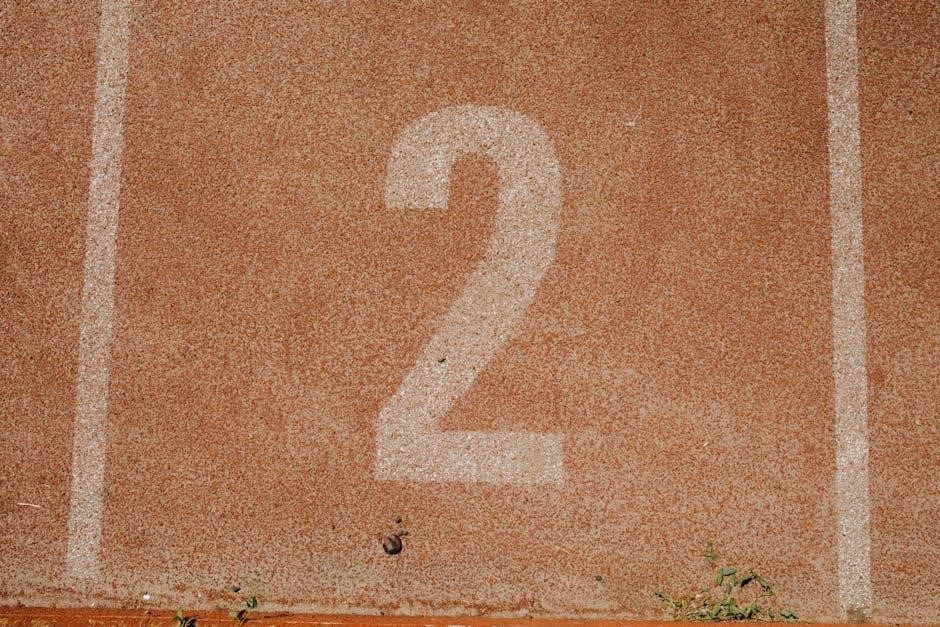Fractions represent parts of a whole, and visualizing them on a number line helps understand their value relative to whole numbers and other fractions.
1.1. Definition of Fractions
A fraction represents a part of a whole and is composed of a numerator (top number) and a denominator (bottom number), separated by a fraction line. The numerator indicates the number of equal parts, while the denominator shows how many parts make up the whole. For example, in the fraction 1/2, the numerator “1” represents one part, and the denominator “2” indicates the whole is divided into two equal parts. Fractions can be less than, equal to, or greater than 1, and they can also be negative. Understanding fractions is essential for grasping concepts like division, ratios, and probabilities in mathematics.
1.2. Importance of Visualizing Fractions
Visualizing fractions on a number line is crucial for understanding their value and relationship to whole numbers. It helps students grasp that fractions represent parts of a whole and can be positioned between integers. By seeing fractions on a number line, learners can better comprehend concepts like equivalence, comparison, and ordering. This method also aids in recognizing patterns and sequences, making abstract fraction concepts more tangible. Additionally, it enhances problem-solving skills by providing a clear, visual reference for operations like addition and subtraction. Visualization is particularly beneficial for developing a foundational understanding of fractions, which is essential for advanced math skills.
1.3. Overview of Number Line Representation
A number line is a visual tool used to represent numbers, including fractions, in a sequential manner. It consists of a straight line with evenly spaced marks, each representing a specific value. Fractions are placed on the number line based on their value relative to whole numbers. The fraction line divides the numerator (top number) and the denominator (bottom number), indicating how many parts the whole is divided into. By plotting fractions on a number line, learners can see their position between integers, making it easier to compare and understand their relationships. This representation also helps identify equivalent fractions, as they occupy the same point on the line. Using number lines simplifies fraction concepts, making them more accessible and tangible for learners. This method is particularly effective for visual learners and enhances overall math comprehension.

How to Plot Fractions on a Number Line
Plotting fractions on a number line involves dividing the line into equal parts based on the denominator. Each part is labeled with the denominator’s value, and the fraction is placed where the numerator indicates. This method simplifies understanding and visualizing fractions.
2.1. Understanding the Fraction Line
The fraction line is a horizontal line separating the numerator and denominator in a fraction. It indicates division, where the numerator is divided by the denominator. This line plays a crucial role in defining the value of the fraction. Understanding its purpose helps in accurately plotting fractions on a number line. By dividing the number line into equal segments based on the denominator, students can visually represent the fraction’s value, making it easier to compare and order fractions. This fundamental concept is essential for building a strong foundation in fraction operations and real-world applications. Proper use of the fraction line ensures clarity in mathematical representations and problem-solving.
2.2. Steps to Plot Fractions Less Than 1
To plot fractions less than 1 on a number line, start by identifying the denominator, which determines the number of equal segments between 0 and 1. Divide this segment into parts equal to the denominator. For example, for 3/4, divide the segment into 4 equal parts. Next, count the numerator to locate the fraction’s position. In the case of 3/4, move 3 parts from 0. This visual method helps students understand the fraction’s value relative to whole numbers and other fractions. Always ensure the number line is clearly marked for accurate plotting. This step-by-step approach simplifies fraction representation and enhances mathematical understanding.
2.3. Steps to Plot Fractions Greater Than 1
To plot fractions greater than 1 on a number line, first identify the whole number part and the fractional part. For example, in 2 3/4, the whole number is 2, and the fraction is 3/4. Locate the whole number on the number line, then divide the segment following it into parts equal to the denominator. In this case, divide the segment after 2 into 4 equal sections. Count the numerator, 3, to mark the fraction’s position. This method ensures accurate placement of improper fractions or mixed numbers, helping students visualize values beyond whole numbers. Always label each section clearly to avoid confusion.
2.4. Steps to Plot Negative Fractions
Plotting negative fractions on a number line involves understanding direction and magnitude. Start by locating zero. Negative fractions extend to the left of zero. For example, to plot -3/4, move left from zero. Divide the segment between zero and the next whole number in the negative direction into parts equal to the denominator, which is 4. Locate the numerator, 3, in this divided segment. Place a mark at the third division point to represent -3/4. Label this point clearly. This method helps students visualize negative fractions as reflections of their positive counterparts, reinforcing the concept of symmetry on the number line. Ensure each division is equal for accuracy. This approach aids in understanding the relationship between negative fractions and whole numbers, making abstract concepts more tangible for learners; Always verify the position by counting the divisions to confirm the fraction’s placement. This step-by-step process enhances spatial reasoning and mathematical comprehension. By consistently applying this method, students build confidence in handling negative fractions on a number line, which is essential for advanced mathematical operations. Proper labeling prevents confusion and ensures clarity in understanding the fraction’s value relative to zero and positive numbers.

Understanding Equivalent Fractions on a Number Line
Equivalent fractions represent the same part of a whole, making them equal in value. On a number line, they occupy the same position, ensuring consistency and clarity.
3.1. Definition of Equivalent Fractions
Equivalent fractions are fractions that represent the same value but have different numerators and denominators. For example, 1/2, 2/4, and 3/6 are equivalent because they all equal 0.5. On a number line, these fractions will align at the same point, demonstrating their equality visually. This concept is fundamental in simplifying and comparing fractions, as it shows that different-looking fractions can be the same in value. Understanding equivalent fractions enhances mathematical flexibility and accuracy in various operations, such as addition, subtraction, and equation solving. The number line provides a clear visual tool to identify and verify these equalities, making learning more intuitive and accessible.
3.2. Identifying Equivalent Fractions on a Number Line
Equivalent fractions can be easily identified on a number line by observing their alignment at the same point. For instance, 1/2, 2/4, and 3/6 all mark the halfway point between 0 and 1, demonstrating their equivalence. By dividing the number line into equal segments, students can visually confirm that fractions like 2/4 and 1/2 occupy the same space, reinforcing the concept of equivalence. This method simplifies comparing fractions and understanding their relationships, making it easier to recognize that different fractions can represent the same value. The number line serves as a practical tool for visual verification of equivalent fractions, enhancing learning and comprehension.
3.3. Simplifying Fractions on a Number Line
Simplifying fractions on a number line involves reducing them to their lowest terms while maintaining their value. For example, 2/4 can be simplified to 1/2 by dividing both numerator and denominator by 2. Visualizing this on a number line, both 2/4 and 1/2 mark the midpoint between 0 and 1, confirming they are equivalent. This process helps students understand that simplifying a fraction does not change its position on the number line, ensuring the same value is maintained. By using the number line as a visual aid, learners can easily identify and simplify fractions, enhancing their mathematical proficiency and conceptual understanding.

Comparing and Ordering Fractions on a Number Line
Comparing and ordering fractions on a number line involves determining their relative sizes and arranging them from least to greatest or greatest to least visually.
4.1. Comparing Two Fractions

Comparing two fractions on a number line involves identifying their positions relative to each other. This helps determine which fraction is larger or smaller. By aligning the fractions on the number line, students can visually see their values. For example, 1/2 and 3/4 can be compared by marking their positions, showing that 3/4 is greater. This method enhances understanding of fraction magnitude and relationship. It also aids in developing essential math skills for further concepts like addition and subtraction of fractions. Visual comparison is particularly useful for introducing fraction operations in an intuitive way.
4.2. Ordering Fractions from Least to Greatest
Ordering fractions from least to greatest on a number line involves arranging them based on their values. Start by marking each fraction’s position on the line. Fractions closer to zero are smaller, while those farther to the right are larger. For example, 1/4, 1/2, and 3/4 can be ordered by comparing their distances from zero. This visual method helps students understand fraction magnitudes and relationships. Worksheets and activities often include exercises where fractions are plotted and then arranged in sequence. This skill is essential for operations like addition and subtraction, as it builds a strong foundation in fraction sense and math reasoning.
4.3. Ordering Fractions from Greatest to Least
Ordering fractions from greatest to least involves arranging them by their values, starting with the largest. Plot each fraction on a number line, with larger fractions appearing further to the right. For instance, among 1/2, 1/4, and 3/4, 3/4 is the largest, followed by 1/2, then 1/4. When fractions have different denominators, find common denominators to compare numerators; Equivalent fractions, like 1/2 and 2/4, are equal and should be grouped together. Negative fractions are placed left of zero, with those closer to zero being greater. Using benchmarks and regular practice with worksheets or interactive tools can enhance accuracy and understanding. This skill is crucial for real-world applications, such as cooking or construction, where precise measurements are essential.

Printable Worksheets for Fractions on a Number Line
Downloadable PDF worksheets help students practice identifying, placing, and comparing fractions on a number line, with exercises tailored for 3rd, 4th, and higher grades.
5.1. Free PDF Worksheets for 3rd Grade
Engage 3rd graders with free PDF worksheets that focus on identifying and placing fractions like 1/2, 1/4, and 1/8 on a number line. These exercises use visual aids to help students understand fraction values and their positions relative to whole numbers. Activities include matching games, sequencing fractions, and identifying equivalent fractions. The worksheets are designed to build foundational skills, making fractions more accessible and fun for young learners. Perfect for classroom use or homework, these resources support early math development and fraction comprehension. They are easy to download and print, offering a structured approach to learning fractions.
5.2. Free PDF Worksheets for 4th Grade
Enhance 4th graders’ understanding of fractions with free PDF worksheets designed for their skill level. These resources focus on identifying, placing, and comparing fractions like 3/4, 5/6, and improper fractions on a number line. Activities include matching equivalent fractions, ordering fractions from least to greatest, and converting between improper fractions and mixed numbers. The worksheets incorporate visual number lines to help students grasp fraction values and their relationships. They also include word problems to apply fraction skills in real-world contexts. Perfect for classroom or independent practice, these worksheets provide a comprehensive way to master fraction concepts and build math confidence.
5.3. Worksheets for Identifying Fractions
Worksheets for identifying fractions on a number line are essential tools for building foundational math skills. These exercises help students recognize and name fractions by visually locating them on a number line. Activities include labeling points on a number line with fractions, such as 1/2, 3/4, and identifying equivalent fractions like 2/4 or 6/8. Students also practice determining the fraction represented by shaded segments or markers. These worksheets use clear, simple number lines, making it easy for learners to connect abstract fraction concepts with concrete visual representations, fostering a deeper understanding of how fractions relate to whole numbers and each other.
5.4. Worksheets for Placing Fractions
Worksheets for placing fractions on a number line are designed to help students accurately locate and mark fractions between whole numbers. These exercises often include number lines with increments based on the denominator, guiding students to plot fractions like 1/2, 3/4, or 5/6. By dividing the number line into equal parts, students learn to visualize where each fraction falls. Activities may involve shading segments, marking points, or matching fractions to their corresponding positions. These worksheets reinforce the concept of fractions as parts of a whole and prepare students for more complex tasks like ordering and comparing fractions on a number line.
5.5. Worksheets for Comparing Fractions
Worksheets for comparing fractions on a number line are essential for developing an understanding of fraction relationships. These exercises often involve marking or shading fractions and using symbols like <, >, or = to show their relative values. Students learn to identify which fraction is greater or lesser by observing their positions on the number line. Activities may include matching equivalent fractions or determining if fractions are greater than or less than a given value. These worksheets provide a visual approach to comparing fractions, helping students build a strong foundation for more advanced fraction operations and real-world applications.
Activities and Games for Learning Fractions
Interactive number line activities, fraction bingo, and scavenger hunts make learning fractions engaging and fun, helping students visualize and understand fraction concepts through hands-on experiences.
6.1. Interactive Number Line Activities
Interactive number line activities engage students with hands-on learning. These include marking fractions on a line, identifying equivalent fractions, and sequencing fractions from least to greatest. Students gain a visual understanding of fraction values, improving their ability to compare and order fractions. Such activities also help in developing problem-solving skills and reinforcing fraction concepts through practical exercises. These interactive tasks make learning fractions enjoyable and effective, ensuring students grasp key ideas intuitively.
6.2. Fraction Bingo Games
Fraction bingo games are a fun and interactive way to teach students about fractions. These games involve creating bingo cards with fractions and calling out fraction terms for students to mark. They help students recognize and identify fractions visually, promoting quick recall and understanding. Bingo games can also include equivalent fractions, allowing students to match fractions that represent the same value. This activity encourages teamwork, healthy competition, and active participation. By using bingo, students can engage with fractions in a lively manner, making learning enjoyable and effective. These games are suitable for various grade levels and can be adapted to focus on specific fraction concepts, such as comparing or ordering fractions.
6.3. Fraction Scavenger Hunts
Fraction scavenger hunts are an engaging way to help students identify and understand fractions in real-world contexts. Teachers create a list of fractions for students to find and mark in their surroundings. This activity encourages students to recognize fractions in everyday objects, such as halves in a pizza or thirds in a divided cake. By exploring their environment, students develop a deeper understanding of how fractions represent parts of a whole. Scavenger hunts also promote teamwork, critical thinking, and problem-solving skills. They make learning fractions interactive and fun, while reinforcing concepts like equivalent fractions and numerical relationships. This hands-on approach enhances retention and enthusiasm for fraction learning.

Teaching Fractions on a Number Line
Teaching fractions on a number line involves plotting points to visualize values, comparing sizes, and identifying equivalent fractions, enhancing conceptual understanding through interactive and visual methods.
7.1. Classroom Strategies
Effective classroom strategies for teaching fractions on a number line include using visual aids like large-scale number lines, incorporating interactive activities, and providing hands-on practice with worksheets. Teachers can start by introducing the concept with whole numbers, then gradually incorporate fractions, emphasizing how they divide the space between whole numbers. Group activities, such as plotting fractions together, encourage collaboration and peer learning. Additionally, using real-world examples helps students connect abstract concepts to practical scenarios, reinforcing their understanding of fractions as parts of a whole. These strategies create a comprehensive and engaging learning environment for students to grasp fraction concepts effectively.
7.2. Lesson Plans for Elementary Grades
Lesson plans for teaching fractions on a number line to elementary grades focus on hands-on activities and visual learning. Start with an introduction to fractions using number lines, highlighting how they represent parts of a whole. Use printable worksheets to guide students in plotting fractions like 1/2 or 3/4. Incorporate games and group work to make learning interactive. For example, students can label points on a number line or match equivalent fractions. Real-world examples, such as measuring lengths or dividing food, help students connect fractions to everyday life. Assign worksheets for homework to reinforce plotting and comparing fractions, ensuring a strong foundation for future math skills.
7.3. Using Real-World Examples
Real-world examples are essential for helping students grasp fractions on a number line. For instance, dividing a pizza among friends or measuring ingredients for a recipe can be visualized as fractions. By relating fractions to everyday scenarios, such as splitting a toy car track into equal parts or comparing distances on a map, students can better understand their practical value. Using money examples, like dividing coins equally, also makes learning relatable. These examples bridge abstract concepts with tangible situations, making it easier for students to plot and compare fractions on a number line and see how they represent real-life divisions of whole quantities.

Assessing Understanding of Fractions
Assessing fraction understanding involves quizzes, tests, and project-based tasks. Peer and self-assessment activities help gauge student mastery of plotting and comparing fractions on a number line effectively.
8.1. Quizzes and Tests
Quizzes and tests are essential tools for evaluating students’ grasp of fractions on a number line. These assessments often include identifying fractions, plotting them accurately, and comparing their values. Multiple-choice questions and fill-in-the-blank exercises are commonly used to ensure understanding. Tests may also incorporate word problems that require students to apply their knowledge of fractions in real-world contexts. By regularly administering these assessments, educators can identify areas where students may need additional support, ensuring a solid foundation in fraction concepts before moving on to more complex topics. This structured approach helps in tracking progress and reinforcing learning effectively.
8.2. Project-Based Assessments
Project-based assessments offer a hands-on approach to evaluating students’ understanding of fractions on a number line. These projects often involve creating visual representations, such as drawing number lines with marked fractions or designing real-world applications like measuring lengths or dividing objects. Students may also develop interactive activities, such as games or puzzles, to demonstrate their knowledge. Additionally, projects can include problem-solving tasks, like solving fraction word problems using number lines or identifying equivalent fractions in practical scenarios. These assessments encourage creativity and critical thinking while providing a comprehensive view of a student’s mastery of fraction concepts. They also foster deeper engagement with the material.
8.3. Peer and Self-Assessment
Peer and self-assessment strategies empower students to take ownership of their learning in understanding fractions on a number line. By reviewing their own work or a classmate’s, students can identify strengths and areas needing improvement. Self-assessment tools, such as reflection journals or checklists, help students evaluate their progress. Peer assessments involve students comparing their fraction placements on number lines, fostering collaborative learning and discussion. These methods encourage critical thinking, reinforce fraction concepts, and build confidence. They also provide immediate feedback, allowing students to adjust their understanding and application of fractions on a number line effectively. Regular use of these assessments promotes continuous improvement and engagement.

Common Mistakes When Working with Fractions
Common mistakes include misunderstanding fraction concepts, incorrectly plotting fractions on the number line, and misconceptions about equivalent fractions, often due to poor visualization or miscalculations.
9.1. Misunderstanding Fraction Concepts
Misunderstanding fraction concepts often stems from confusing the numerator and denominator roles or misinterpreting the fraction line as a simple separator rather than a division symbol.
Students may struggle with the idea that fractions represent parts of a whole, leading to errors in identifying equivalent fractions or comparing fractions accurately.
Additionally, improper understanding of how fractions relate to whole numbers on a number line can cause difficulty in visualizing their true value.
These misunderstandings often arise from rushed instruction or lack of hands-on activities to reinforce fraction concepts.
Addressing these issues requires a focus on foundational understanding through visual aids like number lines and real-world examples to solidify fraction awareness.
9.2. Errors in Plotting Fractions
Common errors in plotting fractions on a number line include miscounting intervals, leading to incorrect placement of fractions.
Students often struggle with fractions greater than 1, mistakenly placing them between 0 and 1 rather than extending beyond whole numbers.
Another frequent error is misaligning equivalent fractions, such as plotting 1/2 and 2/4 at different points instead of aligning them equally.
Additionally, improper fractions and mixed numbers are often confused, causing incorrect positioning relative to whole numbers.
To address these errors, using visual aids like marked intervals and emphasizing the relationship between numerators and denominators can improve accuracy in plotting fractions on a number line.
9.3. Misconceptions About Equivalent Fractions
A common misconception is that equivalent fractions must have the same numerator or denominator, leading to confusion when simplifying.
Students often believe that fractions with different numerators or denominators cannot be equal, even if they represent the same value.
Another misconception is that simplifying a fraction changes its value, rather than just its form.
Additionally, some students struggle with visualizing equivalent fractions on a number line, thinking that different-looking fractions cannot align at the same point.
Addressing these misconceptions requires emphasizing that equivalent fractions represent the same part of a whole, regardless of their form or appearance.
Using number lines and visual comparisons can help clarify and correct these misunderstandings in understanding equivalent fractions.

Advanced Topics in Fractions on a Number Line
Exploring improper fractions, mixed numbers, and unlike denominators enhances understanding. Real-world applications demonstrate fractions’ practical relevance, making abstract concepts tangible for advanced learners.
10.1. Improper Fractions and Mixed Numbers
Improper fractions, where the numerator exceeds the denominator, can be converted to mixed numbers by dividing the numerator by the denominator. This process helps in understanding their placement on a number line, as mixed numbers represent whole numbers plus fractions. For example, 5/4 is equivalent to 1 1/4, which can be plotted at 1.25 on the number line. Visualizing these conversions enhances the ability to compare and order fractions accurately, bridging the gap between abstract concepts and practical applications in real-world problems. This skill is essential for advanced mathematical operations and problem-solving strategies.
10.2. Fractions with Unlike Denominators
Fractions with unlike denominators can be challenging to compare and plot on a number line. To overcome this, find a common denominator by identifying the least common multiple (LCM) of the denominators. Once converted, these fractions can be easily visualized and compared. For example, 1/2 and 3/4 can be plotted by dividing the number line into quarters, showing their precise locations. This method enhances understanding of their relative values and simplifies operations like addition and subtraction. Visualizing fractions with unlike denominators on a number line is a practical skill for real-world applications, such as measuring ingredients or dividing resources.
10.3. Fractions in Real-World Applications
Fractions are essential in numerous real-world scenarios, such as cooking, construction, and finance. For instance, recipes often require measuring ingredients like 3/4 cups of flour, which can be visualized on a number line to ensure accuracy. In construction, understanding fractional measurements is crucial for precise cuts and mixes. Additionally, fractions appear in financial contexts, such as interest rates or investment returns. Visualizing these fractions on a number line helps individuals make informed decisions and avoid errors. By mastering fractions, individuals can apply mathematical concepts to practical problems, enhancing their everyday efficiency and problem-solving skills. Real-world applications highlight the importance of fraction proficiency.
